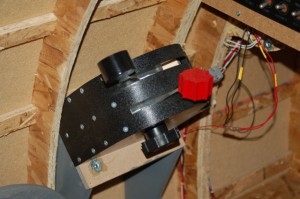I _finally_ won the LCD lottery on Tuesday! (My wife referred to it as me finding the golden LCD in the chocolate bar…)
This means that I’ll be able to finish off the third projector on Saturday! I’m really looking forward to that. After I’ve got that finished I’m going to start creating legs for the screen segments.
I still need to decide how I’m going to build the feet – they need to have adjusters on them because of the poor pour quality of my shop floor. I’ll probably go the simple route and use 1/4-20 bolts in to t-nuts for that.
With the exception of being able to change the board ID code function, the Gazoutta 16 firmware is completed and tested. I got the sockets I needed for the bus transceivers so I should be able to fully test the daisy-chain feature as well.
The firmware takes up less than 3k of the available 30k space on the AVR so there is plenty of room for making the board do more – especially since I’ve included pins for an I2C interface on the board itself. There’s an I2C interface library for Arduino that makes that easy to use.
